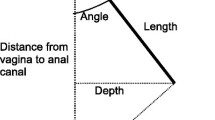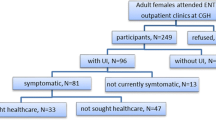Abstract
Purpose
To investigate the coexistentence of anal incontinence (AI) in patients with urinary incontinence (UI).
Materials and methods
UDI 6 questionnaire was applied to consecutive 800 patients for the determination of symptomatic UI. Cases were also questioned for AI. The patients with the complaint of UI were evaluated for the coexistence of AI. Each patient with AI, had completed the Cleveland Clinic Florida Fecal Incontinence questionnaire for the determination of the severity of AI. Chi-square and Mann–Whitney U test were used for the evaluation of qualitative data. Multivariable analysis using logistic regression was done to test the overall significance of all variables that were significantly associated with UI using univariate analysis.
Results
There were 233 (29.1%) cases of UI and 105 (13.1%) cases of AI. 60 (7.5%) of these patients were suffering from both UI and AI. 60 (57.1%) of 105 patients with AI also had UI. In patients with UI, the coexistence of AI was found in 25.7%. There was a positive correlation between UI and AI (R = 0.240, Chi-square P < 0.001). In logistic regression model, AI [(OR) 3.5, 95% confidence interval 2.26, 5.49], parity and episiotomy were found to be associated with UI. Parity and vaginal delivery by episiotomy were risk factors for the occurrence of AI.
Conclusion
AI is positively correlated with UI patients. Symptoms of AI must be questioned in all gynecology patients. Unnecessary episiotomy should be avoided.
Similar content being viewed by others
Abbreviations
- AI:
-
Anal incontinence
- UI:
-
Urinary incontinence
- DI:
-
Detrusor instability
- SUI:
-
Stress urinary incontinence
References
Maclernan A, Taylor A, Wilson D (2000) The prevalence of pelvic floor disorders and their relationship to gender, age, parity and mode of delivery. Br J Obstet Gynaecol 107:1460–1470
Perry S, Shaw C, McGrather C (2002) Prevalence of fecal incontinence in adults aged 40 years or more living in the community. Gut 50:480–484. doi:10.1136/gut.50.4.480
Lacima G, Miguel P (2003) Combined fecal and urinary incontinence: an update. Cur Opin Obstet Gynecol 145:405–410. doi:10.1097/00001703-200310000-00009
Shumaker SA, Wyman JF, Uebersax JS, McClish DK, Fantl JA (1994) Health-related quality of life measures for women with urinary incontinence: the incontinence impact questionnaire and the urogenital distress inventory. Qual Life Res 3:291–306. doi:10.1007/BF00451721
Rockwood TH, Church J, Fleshman J (1999) Patient and surgeon ranking of symptoms associated with fecal incontinence. Dis Colon Rectum 42(12):1525–1531. doi:10.1007/BF02236199
Guisse JM, Morris C, Osterweil P, Li H, Rosenberg D, Greenlick M (2007) Incidence of fecal incontinence after childbirth. Obstet Gynecol 109(2):281–288
Maning J, Eyers A, Korda A (2001) Is there an association between fecal incontinence and lower urinary dysfunction. Dis Colon Rectum 44:790–798. doi:10.1007/BF02234696
Jackson S, Weber A, Hull T (1997) Fecal incontinence in women with urinary incontinence or pelvic prolapse. Obstet Gynecol 89:423–427. doi:10.1016/S0029-7844(96)00499-1
Meschia M, Buonaguidi A, Pifarotti P, Somigliana E, Spennaccio P, Amicarelli F (2002) Prevalence of anal incontinence in women with symptoms of urinary incontinence and genital prolapse. Am J Obstet Gynecol 100(4):719–723. doi:10.1016/S0029-7844(02)02215-9
Gordon D, Groutz A, Goldman G (1999) Anal incontinence prevalence among female patients attending an urogynecology clinic. Neurourol Urodyn 18:199–204. doi:10.1002/(SICI)1520-6777(1999)18:3<199::AID-NAU6>3.0.CO;2-U
Leroi A, Weber J, Menard J (1999) Prevalence of anal incontinence in 409 patients investigated for stress urinary incontinence. Neurourol Urodyn 18:579–590. doi:10.1002/(SICI)1520-6777(1999)18:6<579::AID-NAU8>3.0.CO;2-5
Alnaif B, Durtz H (2001) The prevalence of urinary and fecal incontinence in Canadian secondary school teenage girls. Questionnaire study and review of the literature. Int Urogynecol J 12:134–138. doi:10.1007/s001920170079
Ryhammer A, Bek K, Laurberg S (1995) Multiple vaginal deliveries increase the risk of permanent incontinence of flatus and urine in normal premenopausal women. Dis Colon Rectum 38:1206–1209. doi:10.1007/BF02048338
Carroli G, Mignini L (2009) Episiotomy for vaginal birth. Cochrane Database Syst Rev 21(1):CD000081
Conflict of interest statement
None.
Author information
Authors and Affiliations
Corresponding author
Rights and permissions
About this article
Cite this article
Ekin, M., Kupelioglu, L.C., Yasar, L. et al. The coexistence of anal incontinence in women with urinary incontinence. Arch Gynecol Obstet 280, 971–974 (2009). https://doi.org/10.1007/s00404-009-1053-9
Received:
Accepted:
Published:
Issue Date:
DOI: https://doi.org/10.1007/s00404-009-1053-9




